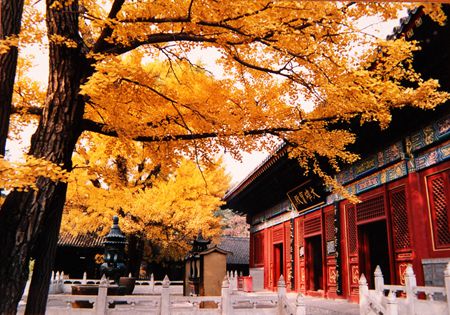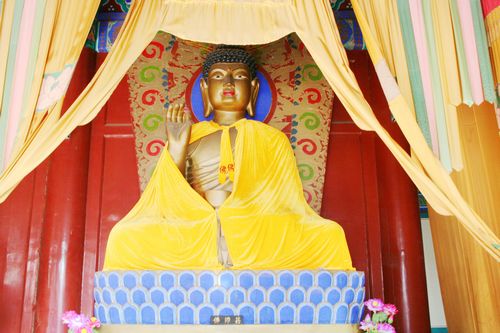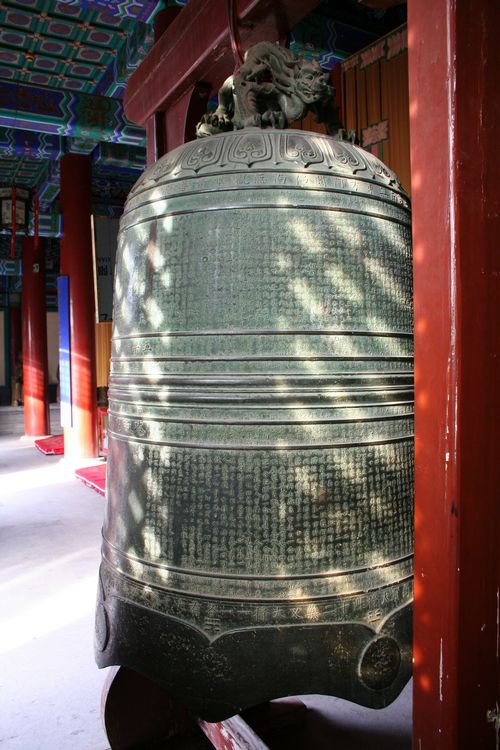7.The Grand Buddha Hall

The Grand Buddha Hall is the main hall of the temple. Buddha statue of Sakyamuni, the founder of Buddhism, is enshrined in the hall.

Sakyamuni
Bodhisattva was born in the middle period of the 6th Century BC (565BC) as a prince of ancient India. Sakyamuni used to be named Gautama Sakyamuni. At the age of 29, he gave up what common people admired and determinately became a monk and cultivated himself according to a religious doctrine. After six years of hard practice and experiencing numerous hardships, his efforts were still in vain. Recognizing the futility of ascetic practices, he went down into the Phalgu and washed himself. He accepted the milk offered by the shepherd girl and recovered his energy. Then he went under a linden, made a seat with Pink Reineckia and sat on it with his legs crossed, facing to the east. He swore to obtain enlightenment. After seven days of meditation and contemplation, overcoming worries and disturbances, he became a great Buddha. After that, he spent 45years preaching his ideas and millions of people were moralized. He passed into Parinirvana at the age of 80.

Bhaisajya Guru
The glazed world, which is located in the east of the world, is one of the Pure Lands where millions of Buddha live. Only if you believe in Bhaisajya guru, you can be relieved of your sufferings and diseases and prolong your life. Therefore, it was very popular for Chinese people from all walks of life to believe in Bhaisajya guru in history.

Eighteen Arhats
The eighteen Arhats were the disciples of Sakyamuni. Before he passed into Parinirvana, Sakyamuni entrusted the eighteen Arhats with bringing good fortune to all flesh.

Tianqi Bronze Bell
Inside the main hall, there is a big bronze bell hanging in the east side. The big bell is an important cultural relic preserved in Hongluosi. With a history of over 370 years, the bell was obliged by the emperor during the reign of Tian Qi Emperor in Ming Dynasty (the year 1625). So it is called Tianqi Bronze Bell. The bell is 171.6 centimeters in height, 103.6 centimeters in diameter and about 1 ton in weight. Made of bronze, the bell has two knobs in the shape of dragon with lotus petals coving the top and the Eight Diagrams at the bottom. The bell was constructed with exquisite workmanship. The whole book of Diamond Sutra was engraved on the surface of the bell. There are 6505 inscription characters all together which are in the style of regular script. The handwriting is clear and graceful with a standard and well-knit composition.
The bronze work in China constitutes a splendid and mysterious pearl of world cultural treasure-house. It reaches the heyday in Ming Dynasty. The bell in Hongluosi is an epitome with fine and smooth lines of characters, ornaments and pictures, balanced curves and scientifically designed wall thickness and deep and vigorous tone. It has been cast with one go with no traces of supplement, which is hard even with modern technology and equipment. As a masterpiece of Ming Dynasty, the bell is now under state protection.

Zi Zai Guanyin, Dragon girl and Shan Cai Boy
Behind the Buddha hill in Grand Bodhisattva Hall, you can see the statue of Zi Zai Guan Yin, with one foot hanging down while the other with willow branches in hand. It is a statue of Guan Yin at ease, which is one of the thirty-three images of Guan Yin statues. Beside him stand a dragon girl and a Shan Cai boy.
Shan Cai boy: it is said that when he was born, a lot of precious jewelries were running out from the earth, so his name was “Shan Cai” (fortune). He was interested in Buddhism and made up his mind to devote himself to Buddhism. He had learned the Buddhism from 53 teachers, and his determination made him become Buddha in the end.
The dragon girl was the daughter of one of the 20 god kings who protect the Buddha. She was 8 years old when she listened to the Wen Shu Buddha’s lecture, and then understood the main idea of Buddhism and became become the Buddha in the end.



